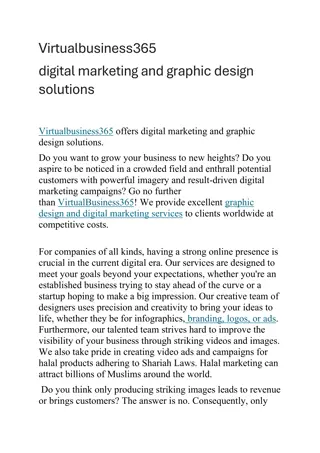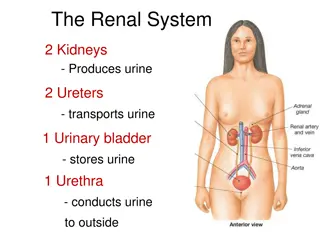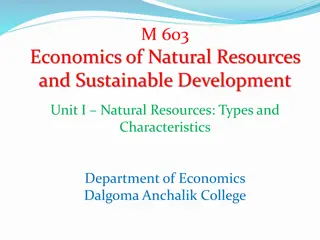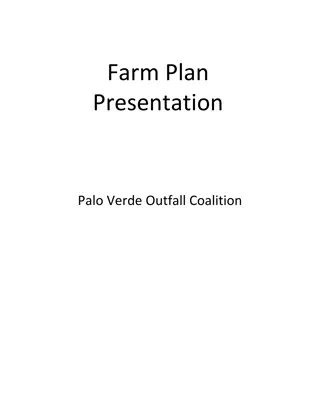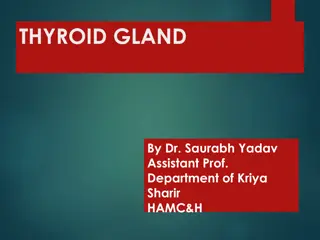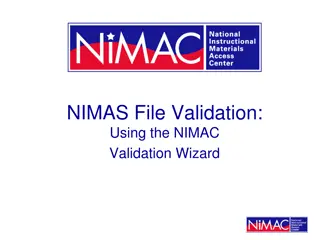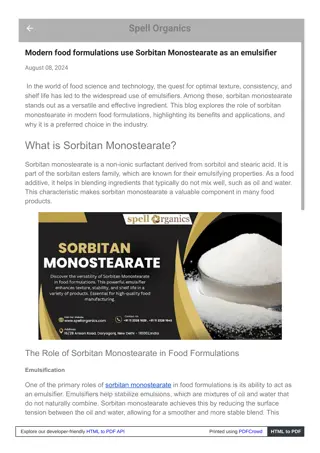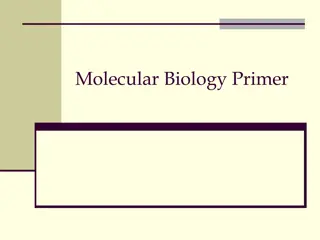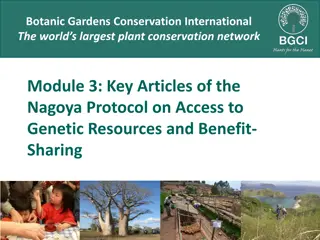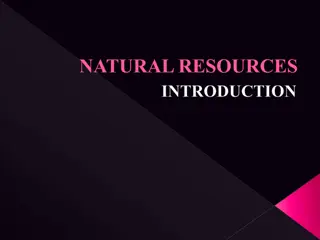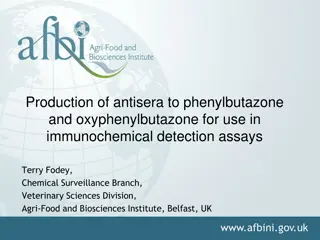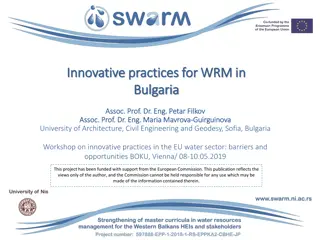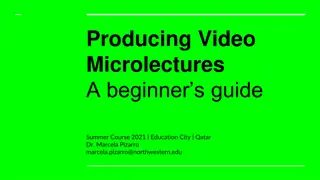Producing NIMAS: Best Practices and Resources
"Explore best practices for producing NIMAS files with valuable reminders, XML tagging resources, metadata guidance, and additional support from NIMAC. Learn about essential NIMAS resources and get insights on XML pointers and table of contents tagging."
Download Presentation

Please find below an Image/Link to download the presentation.
The content on the website is provided AS IS for your information and personal use only. It may not be sold, licensed, or shared on other websites without obtaining consent from the author. Download presentation by click this link. If you encounter any issues during the download, it is possible that the publisher has removed the file from their server.
E N D
Presentation Transcript
Producing NIMAS: Best Practices and Reminders Nicole Gaines March 2, 2021
Todays Webinar Resources for Producing NIMAS XML Tagging Reminders Table of Contents tagging Glossary tags List item tags Pagination tags Alt Text Pointers
Todays Webinar (continued) Metadata Reminders Metadata resources XML <head> tag Transform Excel to OPF tool Metadata Queries New NIMAC Validation Tool: What is on your wish list for the new tool?
Producing NIMAS: Resources The three primary resources for producing NIMAS files are the: NIMAS 1.1 Specification DAISY Structure Guidelines NIMAC Metadata Guidelines
Additional Guidance Further resources are available from the NIMAC at Resources for Publishers & Vendors The National AEM Center also provides NIMAS exemplars and guidance at NIMAS Resources Reach out to the NIMAC if you have questions about how to handle specific content.
1. Table of Contents (TOC) The TOC should not be tagged as a table. The TOC should be tagged using a nested list structure. See this section in the DSG: Daisy Structure Guidelines - Major Structures
Table of Contents Tagging <level1 class="print_toc"> <pagenum id="IDALCAQ" page="front">ii</pagenum> <h1>Unit 1 Contents - Animals Tame and Wild</h1> <list type="pl"> PARENT LIST: This tag wraps the Table of Contents for the whole book. <li>Animal Friends LIST ITEM: Chapter name <list type="pl"> NESTED LIST: This list includes the TOC entries for the Animal Friends chapter. <li> <lic class="toc-line">Taking Care of Pets: How do people take care of pets?</lic> <lic class="toc-pg">4</lic> </li> <li> <lic class="toc-line">People Help Animals: How can people help animals?</lic> <lic class="toc-pg">20</lic> </li> [ ] </list> NESTED LIST closes. </li> LIST ITEM for Animal Friends closes. <pagenum id="IDAIDAQ" page="front">iii</pagenum> <li>Wild Animals LIST ITEM: Chapter name <list type="pl"> NESTED LIST: This list includes the TOC entries for the Wild Animals chapter. <li> <lic class="toc-line">See the Animals: How can we learn about animals by watching them?</lic> <lic class="toc-pg">60</lic>
TOC Tagging (continued) <li>Wild Animals <list type="pl"> NESTED LIST: This list includes the TOC entries for the Wild Animals chapter. <li> <lic class="toc-line">See the Animals: How can we learn about animals by watching them?</lic> <lic class="toc-pg">60</lic> </li> <li> <lic class="toc-line">Animal Neighbors: Which wild animals can we find in our neighborhood?</lic> <lic class="toc-pg">86</lic> </li> <li> <lic class="toc-line">Animals Around the World: How can we help animals around the world?</lic> <lic class="toc-pg">118</lic> </li> </list> NESTED LIST: Chapter list closes. </li> LIST ITEM for Wild Animals closes. </list> PARENT LIST for entire TOC closes. </level1> LIST ITEM: Next chapter name
TOC Re-cap Use a nested list structure for the TOC. A parent <list> should wrap the entire TOC. Nested <list> tags should be used when the TOC is subdivided by chapter and/or by other divisions. The DSG includes additional examples. If you have questions, please contact the NIMAC for further guidance.
2. Glossary Tags Correctly tagging a glossary increases the usability of the NIMAS file. The whole glossary list should be wrapped in <dl> tags, not each entry. See this section in the DSG: DAISY Structure Guidelines - Major Structures
Glossary Syntax <level1 class="glossary"> <h1>Glossary</h1> <dl> <dt>first term</dt> <dd>definition of first term</dd> <dt>second term</dt> <dd>definition of second term</dd> </dl> </level1>
Glossary Example Glossary A alloy - a mixture of two or more metals anarchy - a state of lawlessness, confusion or disorder animism - the belief that bodies of water, animals, trees and other natural objects have spirits
Glossary Tagging Incorrect! <level1 class="glossary"> <h1>Glossary</h1> <level2 class= alphabetic_division > <h2>A</h2> <dl> <dt>alloy</dt> <dd>a mixture of two or more metals</dd> </dl> <dl> <dt>anarchy</dt> <dd> a state of lawlessness, confusion or disorder <dd> </dl> <dl> <dt>animism</dt> <dd>the belief that bodies of water, animals, trees and other natural objects have spirits </dd> </dl>
Glossary Tagging Correct! <level1 class="glossary"> <h1>Glossary</h1> <level2 class= alphabetic_division > <h2>A</h2> <dl> <dt>alloy</dt> <dd>a mixture of two or more metals</dd> <dt>anarchy</dt> <dd> a state of lawlessness, confusion or disorder <dd> <dt>animism</dt> <dd>the belief that bodies of water, animals, trees and other natural objects have spirits </dd> </dl>
3. List Tagging Reminders Do not use paragraph tags inside list items. Use <lic> if there is more than one component to the list item.
List Example How to Start My Old Car 1. Put foot on brake. 2. Depress clutch. 3. Turn key in ignition. 4. Tap gas pedal.
List Tagging Incorrect! <list type= ol"> <hd>How to Start My Old Car</hd> <li><p>Put foot on brake.</p></li> <li><p>Depress clutch.</p></li> <li><p>Turn key in ignition.</p></li> <li><p>Tap gas pedal.</p></li> </list>
List Tagging Correct! <list type= ol"> <hd>How to Start My Old Car</hd> <li>Put foot on brake.</li> <li>Depress clutch.</li> <li>Turn key in ignition.</li> <li>Tap gas pedal.</li> </list>
Page Break After a List Item Do not include a <pagenum> tag inside <li> tags. Close the list item and then provide the new page number.
List Syntax and <pagenum> Incorrect Correct <list type=".."> <hd>...</hd> <li> <lic>...</lic> <lic>...</lic> <pagenum>...</pagenum> </li> <li> <lic>...</lic> <lic>...</lic> </li> </list> <list type=".."> <hd>...</hd> <li> <lic>...</lic> <lic>...</lic> </li> <pagenum>...</pagenum> <li> <lic>...</lic> <lic>...</lic> </li> </list>
4. Pagination Reminders The pagination tag belongs before the page content, even if the print book shows the page number at the bottom of the page. Do not enclose <pagenum> tags in <p> tags.
Pagination Tagging <p><pagenum page= normal >24</pagenum><p> Incorrect! <pagenum page= normal >24</pagenum> Correct!
Page Attribute Reminder The page attribute is required on the <pagenum> tag. There are three options for this attribute: <pagenum page= front >xvii</pagenum> <pagenum page = normal >345</pagenum> <pagenum page = special >G-34</pagenum> More information is found in the DAISY Structure Guidelines.
Describing Images Alt text is a short description of an image that provides access to the information for individuals who are blind or visually impaired. Alt text is not required for NIMAS, but it is very beneficial for students and is recommended. The alt attribute on the <img> tag is used for providing short descriptions: <img id="p_24" src="./images/ch1/p_24a.jpg" alt= Peter Rabbit hops through a field of flowers."/>
Alt Text Pointers We strongly recommend that editorial staff familiar with the material supply alt text. Please do not use placeholder text such as image or equation. If you are not supplying a description, please leave the attribute empty: <img id="p_2" src="./images/ch1/flowers.jpg" alt=""/>
High Quality Alt Text To be high quality, alt text must be: Free of grammatical and spelling errors Age-appropriate in language No more than 1-2 sentences in length The alt text should also match the learning context for the image. If a complex image requires a longer description, the <prodnote> element can be used for this purpose.
Resources for Image Description A starting point for image description resources is found on the NIMAC website: Alt Text Resources Examples of good alt text and long descriptions can be found in the Social Studies NIMAS Exemplar on the AEM Center website. If you have questions, feel free to contact us for further guidance.
NIMAS Metadata The NIMAS specification requires that publishers provide metadata in the OPF file for each NIMAS file. Metadata is not optional for NIMAS. Files may be rejected by the system for upload if required metadata are incorrect or missing.
NIMAS OPF Metadata The NIMAC system automatically extracts the OPF metadata to create the record for the file. Providing complete and correct metadata helps ensure that your customers can find the materials they need in the NIMAC. The OPF also travels with any downloaded file to provide this information to the user.
Metadata Resources The NIMAC Metadata Guidelines document has detailed information on how to prepare NIMAS metadata. There is also a NIMAC Metadata Quick Start Guide to provide a brief introduction or refresher. A new OPF exemplar is also available on the AEM Center website: New OPF Exemplar.
Required Metadata Checklist The NIMAC also provides a downloadable Metadata Checklist. If you are a publisher, please ensure that you provide all required metadata to your conversion vendor. (And, if you are a vendor, please ask the publisher for the metadata if it s not provided to you.)
Metadata & Validation The current NIMAC validation wizard does not evaluate your metadata. Checking metadata for completeness and accuracy is a separate step before files are submitted to the NIMAC. We are looking into adding metadata checks into the new tool being developed this year.
Metadata in the XML <head> Metadata in the NIMAS file set is provided in the OPF only. Please do not include metadata in the <head> tag of the XML file. The <head> tag should always be empty for NIMAS XML.
XML <head> : Incorrect! <!DOCTYPE dtbook PUBLIC "-//NISO//DTD dtbook 2005-3//EN" "http://www.daisy.org/z3986/2005/dtbook-2005-3.dtd"><dtbook xmlns="http://www.daisy.org/z3986/2005/dtbook/" version="2005-3" xml:lang="en"> <head> <meta name="dc:Title" content="Biology"/> <meta name="dc:Creator" content= Gwen Smith"/> <meta name="dc:Creator" content= Amy Johnson"/> <meta name="dc:Creator" content= Edward Baker"/> <meta name="dc:Publisher" content= Educational Publisher"/> <meta name="dc:Date" content="2021-02-12"/> <meta name="dc:Type" content="Text"/> <meta name="dc:Source" scheme="ISBN" content= 2232232233"/> <meta name="dc:Source" scheme="ISBN" content="9782232232232"/> <meta name="dc:Language" content="en"/> </head>
XML <head> : Correct! <!DOCTYPE dtbook PUBLIC "-//NISO//DTD dtbook 2005-3//EN" "http://www.daisy.org/z3986/2005/dtbook-2005-3.dtd"><dtbook xmlns="http://www.daisy.org/z3986/2005/dtbook/" version="2005-3" xml:lang="en"> <head />
Transform Excel to OPF Tool The NIMAC provides a free, optional tool within the NIMAC system to generate correctly formatted and tagged NIMAS OPF metadata. All you have to do is upload the completed NIMAC Metadata Excel sheet to the system and it will generate starter OPFs for each line of the spreadsheet.
Metadata Excel Sheet The spreadsheet template can be downloaded at any time from the NIMAC website: NIMAC Metadata Template The sheet includes a page of instructions and a page for entering data. If you have any questions about filling out the sheet or using the tool, just contact the NIMAC.
Metadata Queries NIMAC staff are happy to assist with any metadata queries that you have. If you are working files for a new program, we invite you to send a PDF and sample OPF for us to review. We will revise the metadata to provide a template for the program materials. Just email us for more information!
We want your input! The NIMAC is working with OverDrive to develop and release a new NIMAS validation tool this year. Please let us know what additional checks or features you would like to see in this tool. Discussions to scope out the project are just getting underway now for a fall release date.
Send your ideas! Please contribute your ideas in the very short survey after this webinar. You re also welcome to contact us by email if you think of an idea later! Please also feel free to use the Additional Comments section of the survey to suggest future training topics for the NIMAC.
Next Week . . . Please join us for Part 2 of this series next week, which will focus on the Notice of Interpretation and producing NIMAS for digital instructional materials. Lynn McCormack and Luis Perez of the National AEM Center will discuss the new digital materials NIMAS exemplar and field questions from publishers and vendors.
Contact us! nimac@aph.org 877-526-4622 This resource was developed under a grant from the US Department of Education, #H327E160001. However, these contents do not necessarily represent the policy of the US Department of Education, and the reader should not assume endorsement by the Federal Government. Project Officer: Rebecca Sheffield, Ph.D.






